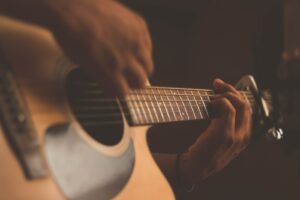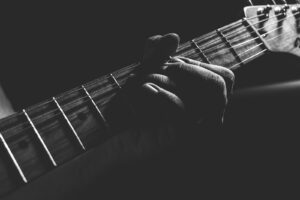There are primarily two sound categories for guitars: clean and dirty.
A clean, untainted, pure tone is created when the guitar is performed without effects.
On the other hand, a dirty guitar sound is a distorted sound that comes from employing effect pedals or increasing the amp while playing guitar.
Several elements affect a guitar’s sound, such as the strings used, the guitar type, the amp and the effect pedals.
The degree of distortion differentiates the Clean guitar sound from the dirty one.
A clean guitar tone contains little distortion.
Your preference for guitar tone is influenced by the genre of music you play.
Jazz, blues, and country music commonly feature clean guitar tones.
Rock, metal, and punk music frequently employ dirty guitar sounds.
Clean Guitar Sound
A clean guitar sound is distinguished by its pristine and transparent nature.
A clean guitar sound generates notes that are unique, clear and do not have distortion or overdrive effects.
Each strum or pluck produces Smooth and balanced tones, bringing forth the guitar’s authentic timbre.
Clean guitar sound with a pleasant vibe is used in music genres such as country, pop, jazz and some clean sections of rock and blues.
The clean sound’s lack of saturation or grit enables intricate playing and highlights the harmonic richness of chords and melodies.
How Do I Get A Good Clean Guitar Tone?
Several things need to be taken into account to get a decent clean guitar tone:
Use your amp’s clean channel
Most amplifiers possess a clean channel that offers a clear tone.
You can utilize the “crunch” or “breakup” channel if the amplifier lacks a clean channel.
However, you must maintain the distortion and the volume levels low.
Utilize a compressor pedal
A compressor pedal aids in producing a clean sound.
This is achieved by balancing the guitar signal’s dynamic range, lowering loudness spikes, and boosting sustain for a smoother and more consistent tone.
Utilize your guitar’s neck pickup
Compared to the bridge pickup, the neck pickup on a guitar creates a brighter, more defined sound.
Due to the neck pickup’s closeness to the guitar’s neck, where the strings are thinner and more easily vibrated, the sound is brighter.
Set your amp’s EQ accordingly
The highs and mids can be emphasized using the EQ settings on your amp to produce a brighter, more defined sound.
Utilize a reverb pedal
A reverb pedal gives the guitar sound more depth and space by simulating the natural reflections in a room.
While keeping a clear and spacious overall sound can improve the clarity of individual notes and chords.
Use a soft touch when playing.
The amount of distortion you produce will increase as you play harder. A mild touch while playing is recommended if you want a clear sound.
Utilize new strings
Strings that are worn out and old will sound lifeless and dreary. Make sure to use brand-new strings for a crisp, clean tone.
Maintain the guitar in a good state
Compared to a neglected guitar, a well-maintained guitar sounds better.
Ensure that you clean your instrument frequently and replace the strings as necessary.
Employ a delay pedal
A delay pedal can generate a clean sound by creating a unique and clear repetition of the guitar signal.
This allows for note separation and gives depth to the sound without adding distortion or overdrive.
Dirty Guitar Sound
Gritty, distorted, and aggressive are the attributes of a dirty guitar sound.
A dirty guitar tone produces heavily distorted or overdriven notes, giving the instrument a strong and raw sound.
The sustain and harmonic content of the guitar tone noticeably improve, becoming more aggressive and edgy.
The distortion gives the guitar a stronger, more energizing tone by adding a coating of fuzz or crunch to the notes.
Dirty guitar sounds are used in music genres such as punk, metal, rock and blues genres since they improve the musical experience.
Depending on the player’s tastes and the musical context, the level of dirt or distortion can range from slight crunch to high-gain saturation.
How Do You Get A Dirty Guitar Tone?
Some of the ways to achieve a dirty guitar sound include:
Make use of a distortion pedal
A distortion pedal is the most popular method for obtaining a dirty guitar tone.
You can explore to locate a distortion pedal that you like because they come in a wide variety.
Employ a fuzz pedal
A distortion pedal that creates a louder sound is called a fuzz pedal. Punk and heavy metal songs frequently employ it.
Utilize a delay pedal
A delay pedal adds richness and texture to the tone, enriching the overall auditory character by creating recurrent echoes of the distorted guitar signal.
Activate the overdrive pedal
An overdrive pedal, a form of distortion pedal, produces a more subdued sound.
Rock and blues music frequently use it.
Increase your amp’s gain setting
You can turn up the gain on your amp to produce a dirty tone if you don’t have a distortion pedal.
However, this can generate dirty sound from the amp.
Therefore, try different settings to locate the best one.
Utilize a compressor pedal
A compressor pedal can assist in creating a dirty sound that is more saturated and aggressive.
This is achieved by highlighting the sustain and boosting the strength of the overdriven or distorted guitar signal.
Use the guitar’s bridge pickup
Compared to the neck pickup, the bridge pickup on a guitar creates a brighter, more forceful sound.
Use a firm touch when playing.
The more distortion you produce, the harder you play. Try playing with a heavy touch if you want a dirty tone.
Utilize a reverb pedal
A reverb pedal can improve a dirty sound by providing space and depth.
This gives the distorted guitar tone a larger-than-life ambiance and a more immersive, dramatic character.
What Are The Dirty Amp Settings?
Amplifier settings for dirty sound:
Higher gain (volume)
Max mid
Lower treble
Lower the guitar volume knob or master volume.
Employ a neck pickup.
Gain is sometimes called “volume,” and overall volume is referred to as “master” in some amplifiers.
Remember these variations.
Lowering the gain and increasing the overall level (also known as master volume or the volume knob on your guitar) can give you a beautiful clean tone.
You’ll also get a brighter note from the bridge pickup, which is good for clean sound.
For a cleaner tone that is warmer and duller (depending on the tune), you can also utilize the neck pickup.
How Do I Get A Good Clean Amp Tone?
Clean sound amp settings:
- Lower gain (volume)
- Lower mid
- Higher treble
- Increasing the guitar volume knob or master volume
- Employ bridge pickup
The settings above apply if you do not have a pedal or an amp with only one channel.
You can easily change the channel into the dirty channel to achieve a dirty guitar sound if the amp possesses two or more channels.




